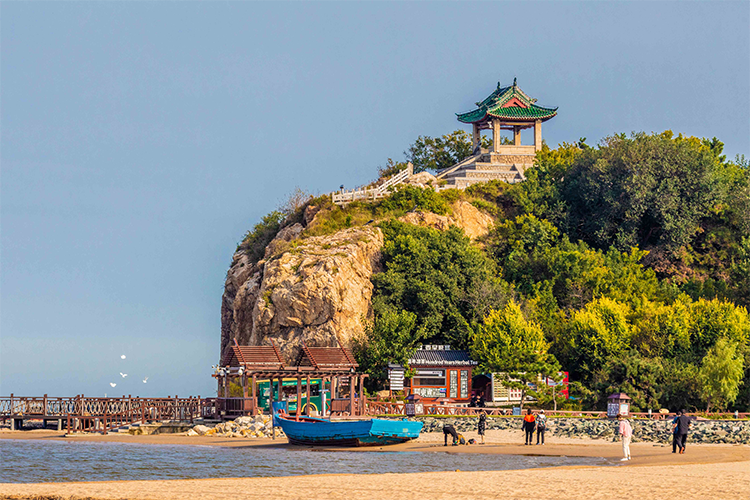China birdwatching at Pigeon Nest Park: Sunrise & Wetland Wonders
Introduction: When the First Light Paints Bohai Bay
When dawn tears away the night over Bohai Bay, thousands of migratory birds lift from the reeds and the stone pavilion on the cliff—Yingjiao Pavilion—slowly gains a rim of gold. This is the daily natural epic at Pigeon Nest Park, the soul of Beidaihe Scenic Area. Renowned as one of the best places on the Chinese coast to watch the sea sunrise, the seaside park carves thousands of acres of mudflats with the tides, preserves red-roofed pavilions that recall famous poems, and measures the seasons with the wings of 168 recorded bird species. Whether you are a photographer chasing the first light or a nature lover hoping for a face-to-face with rare birds, this 300-acre meeting of sea and wetland reveals one of Qinhuangdao’s most poetic mornings.
1. Natural and Cultural Intertwined Experiences
“One pavilion, one poem, one tide” captures the park’s character. Standing atop the traditionally roofed Yingjiao Pavilion, you are on the very spot that inspired Mao Zedong’s 1954 poem “Langtaosha – Beidaihe.” To the east, Bohai Bay unfurls to the horizon; to the west, retreating tides expose broad mudflats that breathe in and out twice daily, staging a repeated geographic transformation.
The park’s ecological crown is its rare tidal mudflat. With tidal ranges of 3–5 meters, up to a thousand acres of mudflats appear at low tide. Fiddler crabs etch abstract patterns in the mud while egrets, herons and more—168 species in total—perform their feeding dramas. Spring migration is spectacular: among the stopovers is the endangered black-billed gull, making this a regular battlefield for international birdwatching competitions.
2. Five Must-Do Experiences
2.1 Sunrise Ceremony: Bathe in Bohai Bay’s First Light
A special summer policy opens the park at 05:00 so visitors can join the light ritual. Yingjiao Pavilion is the prime viewpoint—when the sun climbs over the horizon, the bay explodes from purple to orange. Arrive 30 minutes early and bring a tripod to capture bird silhouettes crossing the rosy sky.
2.2 Intertidal Adventure: Decode Mudflat Ecology
Check the tide table and plan (two hours before high tide is best). Follow the local shellfish gatherers in straw hats to dig razor clams and pick shells. The wooden boardwalk has 20+ bilingual panels explaining sandworm burrows and bird foraging strategies. Families shouldn’t miss the interactive Bird Museum, where a red-crowned crane specimen and live-observation scopes turn a nature lesson into a vivid memory.
2.3 Red Culture Walk: Trace Great Figures’ Footsteps
The Seaview Corridor (Wanghai Changlang), with its white marble statue of Mao and the full text of “Langtaosha” engraved along the walkway, pairs vermilion columns with the blue sea. Folk artists often perform shadow puppetry below. On the 23rd of each month—Mao’s composition anniversary—collective recitations take place, offering a distinct slice of Chinese cultural feeling.
2.4 Birdwatcher’s Paradise: Life in Long-Lens Detail
Early mornings in spring and autumn, roughly 06:00–08:00, are prime birdwatching hours. Beyond common gulls, experienced guides will help you spot the reed-hidden Zhenduan yaji (震旦鸦雀), a China-endemic songbird whose call rings like metal chimes. The eastern birdhouse provides free telescopes; photographers should bring telephoto lenses of 400mm or longer.
2.5 Coastal Slow Life: Discover Beidaihe’s Leisure
When the tide covers the flats in the afternoon, locals relax in seaside cafés sipping hawthorn juice. Try the park’s “Langtaosha” creative ice cream (sea-salt coconut flavor), or rent a tandem bike for the 2.6 km coastal path that passes the Soviet-era Recuperation Hospital complex—an evocative architectural stop.

3. Local Insider Tips
– Hidden photo spot: The rocks 50 meters behind Yingjiao Pavilion offer a classic composition of pavilion plus sunrise.
– Beat the crowds: Weekends in July–August double visitor numbers; aim for Tuesday–Thursday mornings.
– Special event: The annual September “Migratory Birds Music Festival” stages unplugged jazz concerts in the wetland.
– Beware: Souvenir shells sold outside the park often come from Yiwu; the reed-art paintings in the park shop are authentic local handicrafts.
4. Practical Information
Opening Hours:
– Peak season (May–October): 05:00–18:30 (sunrise visitors can book earlier access)
– Off season (November–April): 08:00–17:00
Admission:
– Adult 25 CNY; children under 1.2 m free
– Combo ticket: 65 CNY shared with Biluota Park (valid 48 hours)
Getting There:
– Bus: Take Beidaihe Route 15 to “Pigeon Nest Park” stop, 3-minute walk
– Driving: East parking lot (10 CNY/day). Spaces are limited—arrive before 07:00 when possible
– Cycling: 15-minute ride from Laohushi Park along the coastal boardwalk

Food & Services:
– Langhua Restaurant: local dishes like steamed shrimp dumplings, about 40 CNY per person
– Try local specialties: Yangchangzi (smoked meat sausage) with freshly baked flatbread
As the sun sets and the last golden thread cloaks Yingjiao Pavilion, the tide kisses the rocks and you’ll understand why locals call this the city’s eye. This coastal theater of land and sea satisfies poetic longing while preserving the simplest fishing-harbor memories. Bring this guide and witness Bohai Bay’s daily miracle of awakening.


